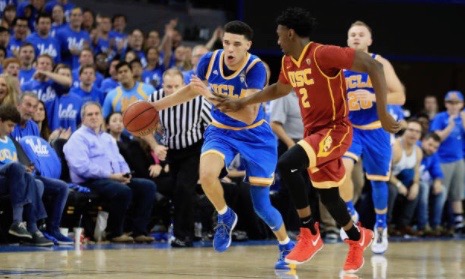By PJ Guippone | Temple University
There have been teams in the past that are offensive juggernaut, but defensively inept. One recent example that comes to mind is the 2014-2015 Notre Dame Fighting Irish led by the likes of Jerian Grant, Demetrius Jackson and Pat Connaughton with now-familiar faces Steve Vasturia and Bonzie Colson coming off the bench. That team made it to an Elite 8 and got robbed by Kentucky of a Final Four berth. That team does not hold a candle to this year’s UCLA Bruins’ team.
Before the season, there were big dreams for this team. Following an extremely underwhelming 15-17 season where success was hard due to having only one offensive weapon, Bryce Alford, there were big dreams for this team because of five-star recruits Lonzo Ball and TJ Leaf. Thanks to this class, which was consensus top-ten, UCLA finally took the step that Steve Alford has wanted. Watching this team on the first day annihilating Pacific 119-80 put the nation on red-alert. Granted, this was Pacific, who is consistently in the bottom half of the West Coast Conference, but UCLA showed everyone what they were about. They were going to be high-flying, dropping bombs from 35 feet that are wetter than the Pacific Ocean.
As the season has progressed, UCLA is now at 25-3 and they have not showed many signs of slowing down. Their 92.3 points per game and 21.7 assists per game are good for tops in the nation. Not amongst power conference teams. This is the highest scoring and best passing team in all of division 1. The last time a power conference team led the nation in scoring was the 07-08 North Carolina Tar Heels, who went on to win the NCAA championship in 2008. That team allowed 71.4 points per game for a +14.9-scoring differential throughout the season. The current UCLA Bruins, who are allowing 75.7 points per game are currently at a +16.6 point differential, almost two full points higher than that national championship squad. Individually, the Bruins have six players scoring at least ten points per game, and three over fifteen per game. Their team assist to turnover ratio is 1.86, led by Lonzo Ball’s 7.6 assists per game and Aaron Holiday’s 4.4. As a team with 76.1 possessions per game, their twelve turnovers per game is extraordinarily low, only turning the ball over on 15% of their possessions. Although they have shown signs of struggling mightily on the defensive end, this team can more than make up for it with their combined 1.22 points per offensive possession. The February 25th matchup against Arizona, who they lost 96-85 to in the first meeting, will really cement UCLA as one of the five best teams in the country, and a true title threat, if they can leave Tucson with a victory.




